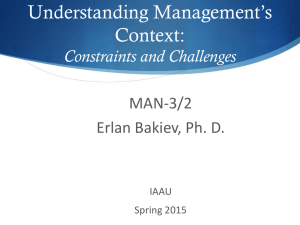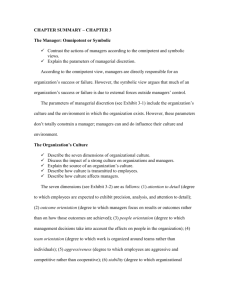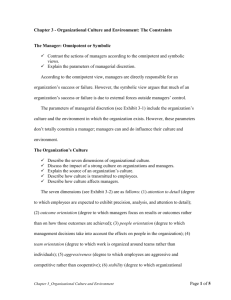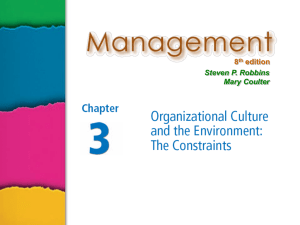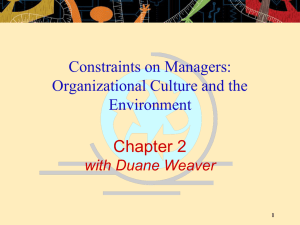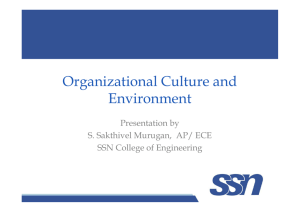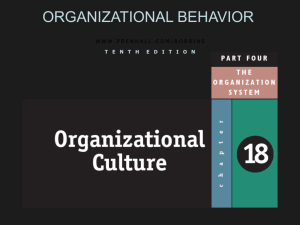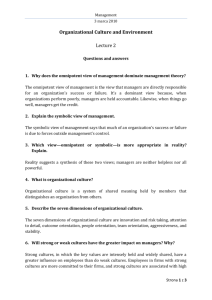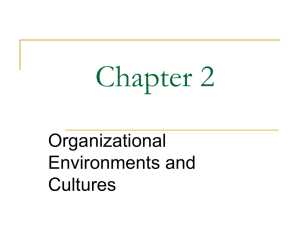Chapter 1 Introduction to Management and Organizations
advertisement
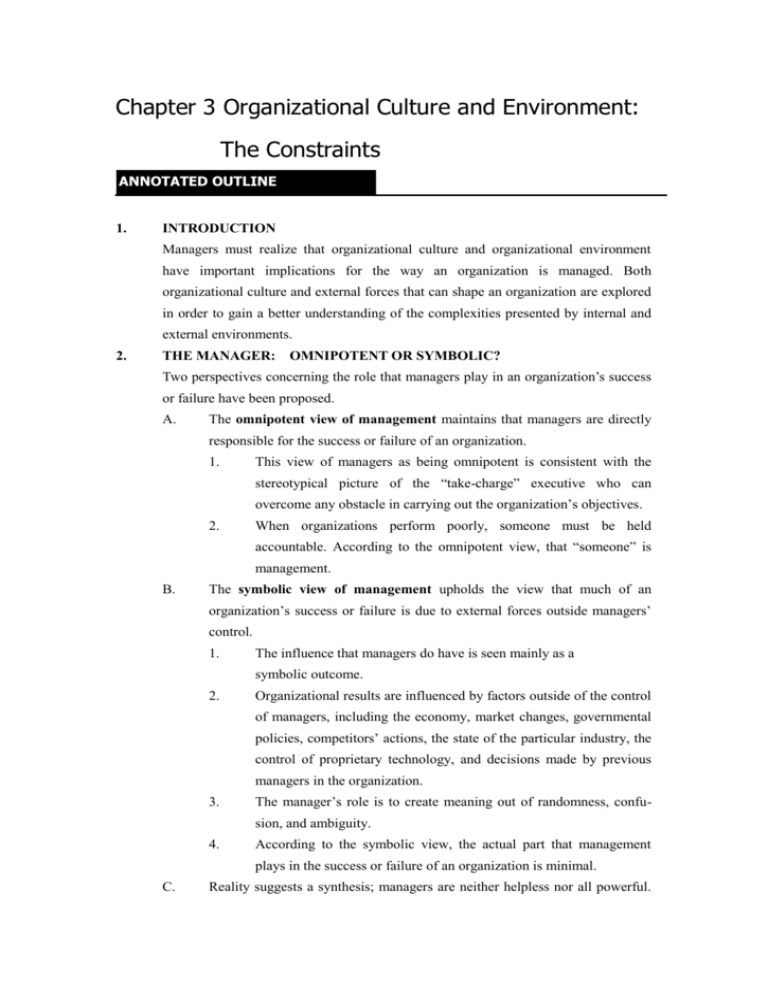
Chapter 3 Organizational Culture and Environment: The Constraints ANNOTATED OUTLINE 1. INTRODUCTION Managers must realize that organizational culture and organizational environment have important implications for the way an organization is managed. Both organizational culture and external forces that can shape an organization are explored in order to gain a better understanding of the complexities presented by internal and external environments. 2. THE MANAGER: OMNIPOTENT OR SYMBOLIC? Two perspectives concerning the role that managers play in an organization’s success or failure have been proposed. A. The omnipotent view of management maintains that managers are directly responsible for the success or failure of an organization. 1. This view of managers as being omnipotent is consistent with the stereotypical picture of the “take-charge” executive who can overcome any obstacle in carrying out the organization’s objectives. 2. When organizations perform poorly, someone must be held accountable. According to the omnipotent view, that “someone” is management. B. The symbolic view of management upholds the view that much of an organization’s success or failure is due to external forces outside managers’ control. 1. The influence that managers do have is seen mainly as a symbolic outcome. 2. Organizational results are influenced by factors outside of the control of managers, including the economy, market changes, governmental policies, competitors’ actions, the state of the particular industry, the control of proprietary technology, and decisions made by previous managers in the organization. 3. The manager’s role is to create meaning out of randomness, confusion, and ambiguity. 4. According to the symbolic view, the actual part that management plays in the success or failure of an organization is minimal. C. Reality suggests a synthesis; managers are neither helpless nor all powerful. Instead, the more logical approach is to see the manager as operating within constraints imposed by the organization’s culture and environment (see Exhibit 3-1). 3. THE ORGANIZATION’S CULTURE Just as individuals have a personality, so, too, do organizations. We refer to an organization’s personality as its culture. A. Organizational culture is the shared values, principles, traditions, and ways of doing things that influence the way organizational members act. This definition implies: 1. Individuals perceive organizational culture based on what they see, hear, or experience within the organization. 2. Organizational culture is shared by individuals within the organization. 3. Organizational culture is a descriptive term. It describes, rather than evaluates. 4. Seven dimensions of an organization’s culture have been proposed (see Exhibit 3-2 and PowerPoint slide 3-9): a. Innovation and risk taking (the degree to which employees are encouraged to be innovative and take risks) b. Attention to detail (the degree to which employees are expected to exhibit precision, analysis, and attention to detail) c. Outcome orientation (the degree to which managers focus on results or outcomes rather than on the techniques and processes used to achieve those outcomes) d. People orientation (the degree to which management decisions take into consideration the effect on people within the organization) e. Team orientation (the degree to which work activities are organized around teams rather than individuals) f. Aggressiveness (the degree to which people are aggressive and competitive rather than easygoing and cooperative) g. Stability (the degree to which organizational activities emphasize maintaining the status quo in contrast to growth) 5. Exhibit 3-3 describes how the cultural dimensions can be combined to create organizations that are significantly different. B. Strong versus Weak Cultures 1. Strong cultures are found in organizations where key values are intensely held and widely shared. 2. Whether an company’s culture is strong, weak, or somewhere in between depends on organizational factors such as size, age, employee turnover rate, and intensity of original culture. 3. A culture has increasing impact on what managers do as the culture becomes stronger. 4. Most organizations have moderate-to-strong cultures. In these organizations, high agreement exists about what is important and what defines “good” employee behavior, for example. 5. Studies of organizational culture have yielded various results. One study found that employees in firms with strong cultures were more committed to their firm than were employees in firms with weak cultures. Organizations with strong cultures also used their recruitment efforts and socialization practices to build employee commitment. An increasing body of research suggests that strong cultures are associated with high organizational performance. C. The original source of an organization’s culture is usually a reflection of the vision or mission of the organization’s founders. The culture is a result of the interaction between the founders’ biases and assumptions and what the first employees subsequently learned from their own experiences. D. How an Organization’s Culture Continues 1. When a culture is in place, practices help to maintain it. 2. Hiring practices reflect the culture in terms of “fit.” 3. Actions of top executives help to maintain the culture. 4. New employees learn the organization’s way of doing things through socialization—the process that helps employees adapt to the organization’s culture. 5. Exhibit 3-5 and PowerPoint slide 3-17 summarize how an organization’s culture is established and maintained. E. How Employees Learn Culture 1. Culture is transmitted principally through stories, rituals, material symbols, and language. 2. Organizational stories are one way that employees learn the culture. These stories typically involve a narrative of significant events or people. 3. Rituals are repetitive sequences of activities that express and reinforce the key values of the organization, which goals are most important, and which people are important or expendable. 4. The use of material symbols is another way in which employees learn the culture, learn the degree of equality desired by top management, discover which employees are most important, and learn the kinds of behavior that are expected and appropriate. 5. Language is often used to identify members of a culture. Learning this language indicates members’ willingness to accept and preserve the culture. This special lingo acts as a common denominator to unite members of a particular culture. F. How Culture Affects Managers. An organization’s culture is important because it establishes constraints on what managers can do. 1. The link between corporate values and managerial behavior is fairly straightforward. 2. The culture conveys to managers what is appropriate behavior. 3. An organization’s culture, particularly a strong one, constrains a manager’s decision-making options in all managerial functions (see Exhibit 3-6). 4. CURRENT ORGANIZATIONAL CULTURE ISSUES FACING MANAGERS Four current cultural issues managers should consider: A. Creating an Ethical Culture (See Exhibit 3-7 and PowerPoint slide 3-21 for suggestions on how managers can create a more ethical culture.) 1. The content and strength of an organization’s culture influence its ethical climate and ethical behavior of its members. 2. A strong organizational culture exerts more influence on employees than does a weak one. 3. The organizational culture most likely to shape high ethical standards is one that is high in risk tolerance and low to moderate in aggressiveness, while focusing on means as well as outcomes. B. Creating an Innovative Culture 1. What does an innovative culture look like? Goran Ekvall provides these characteristics: Challenge and involvement Freedom Trust and openness Idea time Playfulness/humor Conflict resolution Debates Risk taking Swedish researcher C. Creating a Customer-Responsive Culture 1. What does a customer-responsive culture look like? Research shows the following six characteristics routinely present in a customer-responsive culture. (See Exhibit 3-8 and PowerPoint slide 3-23 for actions managers can take to make their cultures more customer responsive.) Type of employee Few rigid rules, procedures, and regulations Widespread use of empowerment Good listening skills Role clarity Employees who are conscientious in desire to please customers D. Spirituality and Organizational Culture 1. Workplace spirituality is a culture where organizational values promote a sense of purpose through meaningful work that takes place in the context of community. 2. 5. Five cultural characteristics evident in spiritual organizations: Strong sense of purpose Focus on individual development Trust and openness Employee empowerment Toleration of employee expression THE ENVIRONMENT The impact of the external environment on a manager’s actions and behaviors cannot be overemphasized. Forces in the external environment play a major role in shaping managers’ endeavors. A. The external environment consists of those factors and forces outside the organization that affect the organization’s performance. 1. The specific environment includes those external forces that have a direct impact on managers’ decisions and actions and are directly relevant to the achievement of the organization’s goals. a. The specific environment is unique and changes with conditions. b. The specific environment varies, depending on the market niche served by the organization. An organization’s main constituencies include customers, suppliers, competitors, and pressure groups. 1) Suppliers include firms that provide materials and equipment as well as firms with financial and labor inputs. Managers seek to ensure a steady flow of the needed materials, equipment, financial, and labor inputs at the lowest possible price. 2) Customers are the reason for an organization’s existence, since customers absorb the organization’s outputs. Customers represent potential uncertainty, particularly if their tastes and desires change. 3) Competitors cannot be ignored. Companies must monitor and respond to their competitors. Most organizations have one or more competitors. 4) Pressure groups cannot be ignored by managers. Changes in social and political movements influence the power exerted by pressure groups. 2. The general environment includes these broad external conditions that may affect the organization: political/legal, sociocultural, demographic, technological, and global conditions. a. Economic conditions include interest rates, inflation rates, changes in disposable income, stock market fluctuations, and the general business cycle. b. Political/legal conditions include the general political stability of countries in which an organization does business and the specific attitudes that elected officials have toward business. Federal, state, and local governments can influence what organizations can and cannot do. (See Exhibit 3-10 and PowerPoint slide 3-28 for a listing of significant legislation affecting businesses.) c. Sociocultural conditions include the changing expectations of society. Societal values, customs, and tastes can change, and managers must be aware of these changes. d. Demographic conditions, including physical characteristics of a population (e.g., gender, age, level of education, geographic location, income, composition of family) can change, and managers must adapt to these changes. e. Technological conditions, which have changed more rapidly than any other element of the general environment. f. Global factors include global competitors and global consumer markets. B. How the Environment Affects Managers Environments differ in their amount of environmental uncertainty, which relates to (1) the degree of change in an organization’s environment and (2) the degree of complexity in that environment (see Exhibit 3-11). 1. Degree of change is characterized as being dynamic or stable. In a dynamic environment, components of the environment change frequently. If change is minimal, the environment is called a stable environment. 2. The degree of environmental complexity is the number of components in an organization’s environment and the extent of an organization’s knowledge about those components. 3. If the number of components and the need for sophisticated knowledge is minimal, the environment is classified as simple. If a number of dissimilar components and a high need for sophisticated knowledge exist, the environment is complex. 4. Because uncertainty is a threat to organizational effectiveness, managers try to minimize environmental uncertainty. C. The more obvious and secure an organization’s relationships are with external stakeholders, the more influence managers have over organizational controls. 1. Stakeholders are any constituencies in the organization’s external environment that are affected by the organization’s decisions and actions. (See Exhibit 3-12 and PowerPoint slide 3-33 for an identification of some of the most common stakeholders.) 2. Stakeholder relationship management is important for two reasons: a. It can lead to improved predictability of environmental changes, more successful innovation, greater degrees of trust, and greater organizational flexibility to reduce the impact of change. b. It is the “right” thing to do, because organizations are dependent on external stakeholders as sources of inputs and outlets for outputs and should be considered when making and implementing decisions. 3. Stakeholder relationships are managed using four steps: a. Identify external stakeholders. b. Determine the specific interests of each stakeholder group. c. Decide how critical these interests are to the organization. d. Determine what specific approach managers should use to manage each relationship, based on environmental uncertainty and importance of the external stakeholder to the organization.
